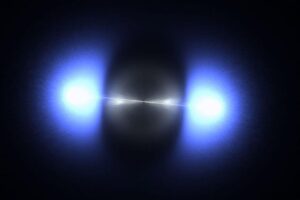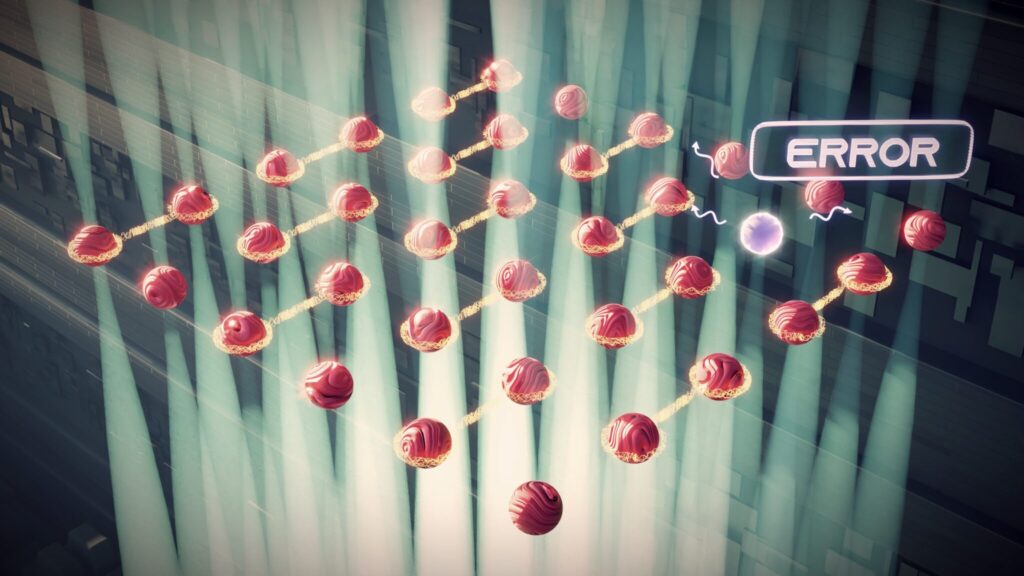
Harvard physicists Mikhail Lukin (foreground) and Markus Greiner work with a quantum simulator. Photo by Jon Chase/Harvard Staff Photographer and published in The Harvard Gazette.
By James Myers
In a breakthrough described as “major,” scientists led by a team at Harvard University have created the first-ever quantum circuit with “logical qubits” that perform error correction in quantum data transmission.
The research leading to the discovery was part of a program funded by the U.S. Defense Advanced Research Projects Agency (DARPA), which hailed the discovery because “logical qubits are a critical missing piece in the puzzle to realize fault-tolerant quantum computing.”

Bloch sphere representation of a qubit. Information in the quantum computer is transmitted and processed by quantum bits, known as “qubits,” which are analogous to the bits used in today’s widely-used phones and computers except far more complex in their structure. Today’s “classical” computer bit can exist in one of two states – “on” or “off” – at a time, while the qubit operates in both states simultaneously in what is called a “superposition.” An outcome in a qubit is a probability of all possible states, distributed spherically. Image: Wikipedia
A qubit is the basic unit of information in a quantum computer, like the bit in phones and computers now in widespread use but far more complex in its structure. The complexity of qubits makes them difficult to connect in quantum computer circuits, and their delicate connections are especially vulnerable to faults and errors caused by interference from external sources like heat, motion, and electromagnetism.
Reduction of errors, or “noise,” in quantum circuits has required extremely costly measures to shield the equipment by supercooling and other measures.
Noise in quantum circuitry has held back the development and expansion of quantum computing’s revolutionary potential. “Suppressing errors is the central challenge for useful quantum computing, requiring quantum error correction for large-scale processing,” the Harvard team, led by Dr. Mikhail Lukin, wrote in the journal Nature.
As reported in Physics World, “For practical large-scale quantum computing, physicists believe that an error rate of about one in a million is needed.”
The Harvard-led researchers used approximately 48 Rydberg qubits in the circuit. As DARPA program manager Dr. Mukund Vengalattore explained in a press release, “Rydberg qubits have the beneficial characteristic of being homogenous in their properties – meaning each qubit is indistinguishable from the next in how they behave. That’s not the case for other platforms such as superconducting qubits where each qubit is unique and therefore not interchangeable.”
These special qubits are especially effective for error correction because their likeness makes them rapidly scalable and easier to manipulate using lasers in a quantum circuit.
As Dr. Vengalattore explained,
“This overcomes the current error-prone methods of performing qubit operations by having to connect them sequentially, which propagates errors throughout the chip. It’s now possible to imagine dynamic reconfiguration of qubits on a quantum chip, where you’re no longer limited to a sequential process of running quantum circuits. Now, you can bring entire collections of qubits, all of them, from one place in the circuit to another place on the circuit using laser tweezers, run an operation, and then put them back where they were originally.”

Physicists have made the first step towards building quantum computers out of individual molecules trapped with laser devices called optical tweezers. Two teams reported their results in Science, in both cases making pairs of calcium monofluoride molecules interact so that they became entangled — a crucial effect for quantum computing. Image and story: The Quantum Insider
Quantinuum, which is the world’s largest integrated standalone quantum computing company, announced in September that it had demonstrated the “first fault-tolerant method using three logically-encoded qubits” to perform a mathematical procedure.
The company stated that “fault-tolerant quantum computing methods are expected to open the way for practical solutions to real-world problems across domains such as molecular simulation, artificial intelligence, optimization, and cybersecurity.”
What’s Next For Quantum Error Correction?
A number far greater than 48 Rydberg qubits will be required to reduce faults in circuitry that will be required for practical and large-scale quantum computing operations, although the discovery marks an important milestone in the quest for fault-tolerant circuits.
Other error-correction methods are being explored, including the ability to obtain a Mid-Circuit Readout (MCR). While observation normally changes the outcome of a quantum process in what’s known as the observer effect, writers from QuEra Computing report in The Quantum Insider that MCR allows measurement of ”the quantum state of a specific qubit or a group of qubits within a quantum computer without disrupting the ongoing computation. In some algorithms, these measurement results can also be reincorporated into the ongoing calculation, affecting it in a process known as ‘feed forward.’ One of the most prominent applications of MCR is in quantum error correction for fault-tolerant quantum computers.”
Machine learning offers potential for quantum error correction, as reported in a press release from the RIKEN Centre for Quantum Computing. The Center has developed an “autonomous correction system that despite being approximate, can efficiently determine how best to make the necessary corrections.”

Illustration of an error in quantum circuitry by Gabrielle Meilikhov/Muza Productions, published by Princeton University
Before an error can be corrected, it must first be detected.
Princeton University Associate Professor of Electrical and Computer Engineering Jeff Thompson and collaborators have developed a method to identify when quantum errors occur without disrupting the qubits.
Using qubits stored in the spin of individual ytterbium atoms held in place by optical tweezers, the university reported that the researchers “were able to monitor the qubits during the computation to detect the occurrence of errors in real time. This measurement causes the qubits with errors to emit a flash of light, while the qubits without errors remain dark and are unaffected.”
Error correction is generally viewed as the most significant barrier to development of cost-efficient and practically effective quantum computers. With these and other advances in detecting and reducing error rates, it is becoming easier to imagine the day when we will be able to connect enough qubits – and keep them connected – to open the future for quantum computing.
At that point, what practical applications will develop for the incredible speed and accuracy of quantum computers?
The future is unclear, but the power for a quantum computing future is closer at hand.



